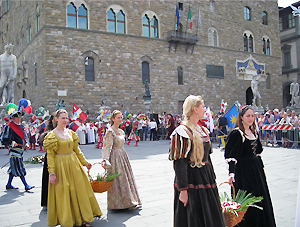Savonarola’s Deathday Commemorations

Another historical reenactment will bring forth long-lost memories of the past in Piazza Signoria on May 23. To commemorate the death and life of Fra Girolamo Savonarola, a historical parade will march through the city on the occasion of his execution.
The parade will proceed from Piazzetta di Parte Guelfa at 9:30 am, going to Via Porta Rossa, Mercato Nuovo, Via Vacchereccia, and ending in Piazza Signoria. There, at 9:45 am, a wreath of flowers will be laid on the granite and bronze plaque that memorializes the place of his execution, as he has no grave. The parade will continue to Por Santa Maria through Via Vacchereccia to throw rose petals in the waters of the Arno river, a symbol for what occurred to what little remained of him, mostly ashes, after his execution.
Fra Girolamo Savonarola, the “meddlesome friar” of 15th century Florence, was executed May 23, 1498. Contrary to popular belief, he was not burnt at stake, like Joan of Arc: he was hung until dead, then burnt. Two fellow Dominicans, Savonarola’s trusted disciples, met the same destiny at the same time.
After the death of Lorenzo the Magnificent de’ Medici, his son Piero de’ Medici had a weak hold of power in Renaissance-era Florence. Savonarola was a drastic change of pace from the rich excess of the noble family, preaching morality, severity, and condemning everyone for their sins. The preacher further grasped power by making prophecies regarding the city: how the Sword of God would come to strike down the unrighteous (which Florentines understood to be the French king Charles VIII and his invading army) and how Florence would grow to become the most virtuous, righteous, richest city in all of Italy.
With all of his sway, a new political party called the Frateschi, which he was technically not a part of but which followed him, started to assume power for themselves until they became the new ruling party of Florence, which made Savonarola the ruler of the city in all but name. His prophecies and status, however, caused tension between Savonarola and the papacy until the Pope excommunicated the so-called prophet, calling on him to prove his claims to be blessed by God. Florentines grew nervous with this edict and immediately called upon Savonarola to prove his word via trial by fire; on the day it was set to happen, however, he was saved by a rainstorm. Public opinion turned against him as the friar was seized for execution.
The friar from Ferrara had been condemned as a heretic and refused to recant. His zeal for exaggerated moral reform turned into political subversion against the Medici rulers and the papacy, so it was politics more than religion that unmade the man. Innocent of all charges, he was immediately mourned as a martyr, which has since confused scholars. Some believe that Savonarola to be a fanatical manipulator of the masses, which was not sufficient ground for his dramatic execution, and some continue to have a negative opinion of the monk.
